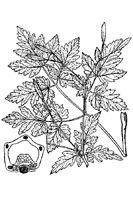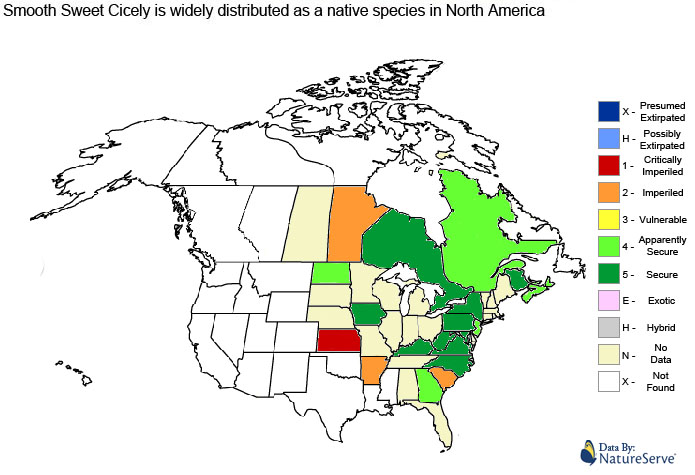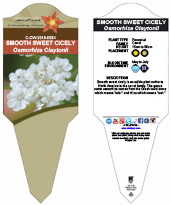

| Plant Name | Sweet Cicely | |
| Scientific Name | Osmorhiza Claytonii | |
| Family | Carrot | |
| Plant Type | Perennial | |
| Start of Blooming Season | May | |
| End of Blooming Season | July |

| Soil Conditions | |
| Soil Moisture | |
| Sunlight | |
| Notes: |

Smooth sweet cicely is a perennial plant which can grow from 15cm to 90cm in height. The taproot of smooth sweet cicely is thick and hairy with a strong anise scent. The leaves are alternate pinnately compound with three to eleven leaflets varying from 1.5cm to 9cm long on each stem. Smooth sweet cicely boasts a clean white rounded cluster of flowers which blooms from mid May into July depending on location. The flowers are hermaphrodite (have both male and female organs) and are pollinated by Insects.The plant is self-fertile.


No known health risks have been associated with smooth sweet cicely. However ingestion of naturally occurring plants without proper identification is not recommended.

 |
-Click here- or on the thumbnail image to see an artist rendering, from The United States Department of Agriculture, of smooth sweet cicely. (This image will open in a new browser tab) |

Smooth sweet cicely can be referenced in certain current and historical texts under the following three names:
Smooth sweet cicely can be translated into the following select languages:
| Arabic | بقدونس إفرنجي الحلو | Bulgarian | Chinese (Sim) | 甜西塞莉 | |
| Croatian | slatka Cicely | Czech | Danish | ||
| Dutch | Esperanto | dolĉa Cicely | Estonian | magus Cicely | |
| Finnish | French | osmorhize | German | Süssdolde | |
| Greek | γλυκό Σικελία | Hebrew | סיסלי ריחני | Hungarian | édes Cicely |
| Italian | Finocchiella | Japanese | 甘いシシリー | Korean | 달콤한 각종 미나리과 식물 |
| Low Saxon | Lithuanian | saldus Cicely | Norwegian | søt Cicely | |
| Persian | Polish | marchewnik anyżowy | Portuguese | cecília doce | |
| Romanian | Cicely dulce | Russian | сладкий Сесили | Slovak | |
| Spanish | Swedish | söt cicely | Tagalog | matamis cicely | |
| Turkish | Ukrainian | солодкий Сесілі | Vietnamese | Cicely ngọt |

| The information provided in this conservation assessment has been provided by the Natureserve Database in conjuction with various federal, provincial, state, county, district, regional, and municipal governments as well as public and private conservation authorities. Information in this section is accurate from the last time this article was updated. | |
 |
Smooth sweet cicely is a secure species in North America. |

 |

 |
The MIROFOSS database offers free printable garden tags for personal and non-profit use. These tags can be used to properly identify plant samples in a garden. Click on the tags shown on the the screen or -click here- to download a full size jpeg image for a smooth sweet cicely identification tag; which can be printed on paper or used with a plastic laser printer. |
 |
What's this? What can I do with it? |

| Description | Radford, A. E., H. E. Ahles & C. R. Bell. 1968. Manual of the Vascular Flora of the Carolinas i–lxi, 1–1183. University of North Carolina Press, Chapel Hill |
| Folklore | Stace, C.A. 2010. New flora of the British isles (Third ed.). Cambridge, U.K.: Cambridge University Press. ISBN 9780521707725 |
| Biology | Voss, E. G. 1985. Michigan Flora. Part II Dicots (Saururaceae-Cornaceae). Bulletin of the Cranbrook Institute of Science 59. |
| Biology | Gleason, H. A. 1968. The Choripetalous Dicotyledoneae. vol. 2. 655 pp. In H. A. Gleason: New Britton and Brown Illustrated Flora of the Northeastern United States and Adjacent Canada. New York Botanical Garden, New York |
| Image Rendering | USDA-NRCS PLANTS Database / USDA NRCS. Wetland flora: Field office illustrated guide to plant species. USDA Natural Resources Conservation Service. |
| Environment | National Audubon Society. Field Guide To Wildflowers (Eastern Region): Alfred A. Knopf. pp 415-420 ISBN 0-375-40232-2 |
| Physical Identification | National Audubon Society. Field Guide To Wildflowers (Eastern Region): Alfred A. Knopf. pp 415-420 ISBN 0-375-40232-2 |
| August 01, 2015 | The last time this page was updated |
| ©2021 MIROFOSS™ Foundation | |
 |